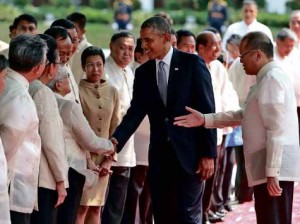No mention of China at signing of defense deal

ALL INTHE FAMILY President Aquino introduces US President Barack Obama to his official family in Malacañang. LYN RILLON
MANILA, Philippines—There was no mention of China at Monday’s signing of the new security pact between the Philippines and the United States but both countries stressed that the Enhanced Defense Cooperation Agreement (Edca) was necessary to address evolving threats in the region.
“As defense and security challenges have become more complex, we, both the Philippines and the United States, have realized the utility of having an agreement that would further enhance our ability to face those complicated challenges,” Defense Secretary Voltaire Gazmin said in remarks after the signing.
While saying that the Edca “allows us to do more,” Gazmin said “it remains anchored on the principles encapsulated” in the 1951 Mutual Defense Treaty (MDT) between the two countries and “guided by what is possible” through the Visiting Forces Agreement (VFA).
Gazmin, Goldberg
Gazmin and US Ambassador to the Philippines Philip Goldberg signed the 10-year Edca in brief ceremonies at the Armed Forces of the Philippines Commissioned Officers Club in the presence of ranking Philippine and American military officials and members of the negotiating panels.
Article continues after this advertisementThe signing took place three hours before US President Barack Obama arrived for a two-day visit in Manila. It took eight months and eight rounds of discussions for the two panels to hammer out the deal.
Article continues after this advertisementThe Philippines is entangled in a bitter territorial dispute with China over islands in the Spratly area believed to be rich in oil and gas reserves. China is claiming almost the entire swath of the South China Sea using maps with a U-shaped, nine-dash line that the Philippines says is encroaching on its 370-kilometer exclusive economic zone.
At the heart of the territorial row between the Philippines and China are the Ayungin Shoal (Second Thomas Shoal) in Palawan province and Panatag Shoal (Scarborough Shoal) off Zambales province.
“The agreement we signed today will be an important part of the existing MDT framework, but it will also serve to update our security alliance to meet the increasingly complex challenges of the 21st century: whether it is terrorism, transnational crime or natural disasters like [Super Typhoon] ‘Yolanda,’” Goldberg said.
Territorial defense
Goldberg said that while the Philippine and US military forces had already been working together “at all levels and across all services, through joint exercises, training and subject matter expert exchanges, to increase their capabilities and interoperability, the Edca serves as recognition by both sides that there is even more we can do together to support the alliance and to promote peace and security in the region.”
“Our countries continuously search for mechanisms that would enhance our individual and collective capabilities to face such security challenges,” Gazmin said. The agreement is a reflection of a “maturing relationship” with the United States, he said. “This is the spirit behind this agreement.”
US troop presence
A primer on the Edca, distributed to the media in lieu of the actual agreement, states that the defense cooperation would allow the Philippines, the oldest of the United States’ five treaty allies in Southeast Asia, to “strengthen its capabilities for external and territorial defense … in a mutually beneficial way in line with what is allowed by the Philippine Constitution.”
All activities under the Edca would have the consent of the Philippines through the Mutual Defense Board (MDB) and the Security Engagement Board (SEB). It also prevents the establishment of US military bases as well as the entry of nuclear weapons to the Philippines.
The agreement would pave the way for an increased number of US troops in the Philippines, already allowed under the VFA, as well as for the Philippines to eventually own buildings and infrastructure constructed by the United States in the “agreed locations,” referring to Philippine military bases that would be identified for use by the two boards.
The agreement states that there would be no stationing of US troops in the Philippines. Instead, they would come on a temporary or rotational basis. Their number would also depend on the “scale and frequency of the activities to be approved by both parties,” the primer said.
The Philippines and the United States will have joint use of facilities in the agreed locations, including those built by the Americans and prepositioned US materiel should there be “timely responses in the event of disasters—natural or otherwise,” the primer added.
Ambassador J. Eduardo Malaya, a member of the Philippine panel, explained to the Inquirer that the Edca did not provide parameters necessary for the United States to establish military bases in the Philippines.
“The three traditional features of foreign military bases do not apply to the agreed locations in the Edca,” Malaya said. These are “extraterritoriality, exclusivity in use and foreign ownership,” he said. “They are not applicable to the areas that would be shared with the US military so there are no US bases.”
An Inquirer source privy to the talks said concrete activities resulting from the agreement could take place in the next two months.
“As soon as specific proposals are brought up to the MDB and SEB, then they can be taken up, discussed and agreed upon,” the source said, requesting anonymity for lack of authority to speak to the media.